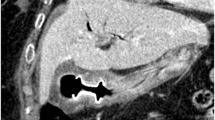Abstract
ESWL of gallbladder stones and subsequent adjuvant oral dissolution is a safe and comfortable therapy of symptomatic cholecystolithiasis. This method is limited on highly selected 10 to 15% of patients. Recent experience indicates that the ideal indication is given in patients with radiolucent solitary gallstones (diameter ≤2 cm) which are harboured in a gallbladder with unimpaired contractility.
1 year after ESWL 80% of those patients present with a stone free gallbladder. Computed tomography of gallstones may probably improve selection of patients and therapeutic success.
Zusammenfassung
Die ESWL von Gallenblasensteinen und die nachfolgende adjuvante orale Auflösungsbehandlung können als sicheres und komfortables Behandlungsverfahren der symptomatischen Cholezystolithiasis gelten. Dieses Verfahren ist auf einen streng ausgewählten Anteil von 10 bis 15% der Patienten mit cholezystolithiasis limitiert. Kürzlich erarbeiete wissenschaftliche Ergebnisse haben gezeigt, daß die ideale Indikation dann gegeben ist, wenn solitäre, nicht röntgendichte Gallensteine mit einem Durchmesser von ≤2 cm vorliegen, die sich in einer Gallenblase mit unbehinderter Kontraktilität befinden.
In solchen Fällen kann davon ausgegangen werden, daß 80% der durch ESWL behandelten Patienten 1 Jahr nach Behandlungsbeginn steinfrei geworden sind. Die Computertomographie von Gallensteinen ist möglicherweise dazu geeignet, die Indikationsstellung, Selektion von Patienten und die Behandlungsergebnisse in der Zukunft zu verbessern.
Similar content being viewed by others
References
Burnett D, Ertran A, Jones R, O'Learky JP, Mackie R, Robinson JE, Salen G, Stahlgren L, van Thiel J, Vassy L, Greenberger N, Hofmann AF: Use of external shock wave lithotripsy and adjuvant ursodiol for treatment of radiolucent gallstones, Dig Dis Sci 1989;34:1011–1015.
Ell C, Kerzel W, Heyder N, Günter E, Rödl W, Flügel H, Domschke W: Piezoelektische Lithotripsie von Gallensteinen. Dtsch Med Wschr 1988;113:1503–1597.
Ell C, Schneider HT, Benninger J, Theobaldy S, Friedel N, Rödl W, Wirtz P, Hahn EG: Significance of computed tomography for shock-wave therapy of radiolucent gallbladder stones. Gastroenterology 1991;101:1409–1416.
Folbert W: Universal-Lithotriptor mit optimierter elektromagnetischer Stoßwellen-Technologie: Siemens Lithostar Plus, in Staritz M, Meyerzum Büschenfelde K-H (Hrsg): Stoßwellenlithotripsie von Gallenblasensteinen. Technologie, Methodik und klinische Ergebnisse. Stuttgart-New York, Thieme, 1991, p. 23.
Forßmann B: Anforderungen an die Stoßwellentechnologie für die Gallensteinzerstrümmerung—Dornier Lithotriptor MPL 9000, in Staritz M, Meyer K-H (Hrsg). Stoßwellenlithotripsie von Gallenblasensteinen. Technologie, Methodik und klinische Ergebnisse. Stuttgart-New York, Thieme, 1991, p. 14.
Greiner L, Jakobeit C: ESWL: Ergebnisse, Erfahrungen, Enttäuschungen, Erwartungen, in Staritz M, Meyer zum Büschenfelde K-H: Stoßwellenlithotripsie von Gallenblasensteinen, Technologie, Methodik und klinische Ergebnisse. Stuttgart-New York, Thieme, 1991, p. 14.
Hickmann MS, Schwesinger WH, Bova JD, Kurtin EW: computed tomographic analysis for in vitro estimation of stone components. Arch Surg 1986;121:289–291.
Hood K, Keightley A, Dowling RH, Dick JA, Mallison CA: Piezoceramic lithotripsy of gallbladder stones. Initial experience in 38 patients. Lancet 1988;I:322–324.
Neuhaus H, Brandstetter K, Hagenmüller F, Gerhardt P, Classen M: Elektromagnetische Stoßwellenlithotripsie von Gallenblasensteinen. Dtsch Med Wschr 1990;115:123–128.
Ponchon T, Barkun AN, Pujol B, Mestas JL, Lambert R: Gallstone disappearance after extracorporeal lithotripsy and oral bile acid dissolution. Gastroenterology 1989;97:457–463.
Rambow A, Staritz M, Klose P, Meyer zum Büschenfelde K-H: Extrakorporale Stoßwellenlithotripsie von Gallenblasensteinen: Wie viele Patienten sind geeignet? Dtsch Med Wschr 1989;114:895–898.
Rambow A, Staritz M, Wosiewitz U, Thelen M, Meyer zum Büschenfelde K-H: Analysis of radiolucent gallstones by computed tomography for in vivo estimation of stone components. Eur J Clin Invest 1990;20:475–478.
Rambow A, Staritz M, Grosse A, Meyer zum Büschenfelde K-H: Electromagnetically generated extracorporeal shock wave lithotripsy and adjuvant combined oral litholysis for therapy of symptomatic gallbladder stones. Digestion 1991;48:220–229.
Sackmann M: Stoßwellentherapie von Gallenblasensteinen—Bilanz 1990, in Staritz M, Meyer zum Büschendelde K-H: Stoßwellenlithotripsie von Gallenblasensteinen, Technologie, Methodik und klinische Ergebnisse. Stuttgart-New York, Thieme, 1991, p. 54.
Sackmann M, Delius M, Sauerbruch T, Holl J, Weber W, Ippisch W, Hagelauer U, Wess O, Brendel W, Paumgartner P: Shockwave lithotripsy of gallbladder stones. The first 175 patients. N Engl J Med 1988;318:393–397.
Sauerbruch T, Delius M, Paumgartner G, Holl J, Wess O, Weber W, Hepp W, Brendel W: Fragmentation of gallstones by extracorporeal shock waves. N Engl J Med 1986;316:818–822.
Staritz M, Rambow A, Floth A, Mildenberger P, Goebel M, Junginger T, Hohenfellner R, Thelen M, Meyer zum Büschenfelde K-H: Electromagnetically generated extracorporeal shock waves for fragmentation of extra-and intrahepatic bile duct stones. Indications, success and problems during 15-month clinical experience. Gut 1990;31:222–225.
Staritz M, Rambow A, Große A, Meyerzum Büschenfelde K-H: Extrakorporale Stoßwellenlithotripsie von Gallenblasensteinen—Erfahrungen von 23 deutschen Lithotripsiezentren. in Staritz M, Meyer zum Büschenfelde K-H (Hrsg): Stoßwellellithotripsie von Gallenblasensteinen Technologie, Methodik und klinische ergebnisse. Stuttgart-New York, Thieme, 1991, p. 145.
Staritz M: ESWL von Gallensteinen—Bisherige Bilanz und Perspektiven für die neunziger Jahre, in Staritz M, Meyer zum Büschenfelde K-H (Hrsg): Stoßwellenlithotripsie von Gallenblasensteinen. Technologie, Methodik und klinische Ergebnisse. Stuttgart-New York, Thieme, 1991, p 160
Staritz M: Is extracorporeal biliary lithotripsy painless? My experience with three shock wave sources. N Engl J Med 1989;320:811.
Wurster H: Der extrakorporale piezoelektrische Lithotriptor. In: Stoßwellenlithotripsie von Gallenblasensteinen, Technologie, Methodik und klinische Ergebnisse, M. Staritz, K.-H. Mayer zum Büschenfelde, (Hrsg.), Thieme, Stuttgart-New York, 1991;2.
Author information
Authors and Affiliations
Rights and permissions
About this article
Cite this article
Staritz, M., Große, A., Rambow, A. et al. Lithotripsy of gallbladder stones in 1992: Improved indications and actual results. Acta Chir Austriaca 24, 251–253 (1992). https://doi.org/10.1007/BF02601759
Issue Date:
DOI: https://doi.org/10.1007/BF02601759




